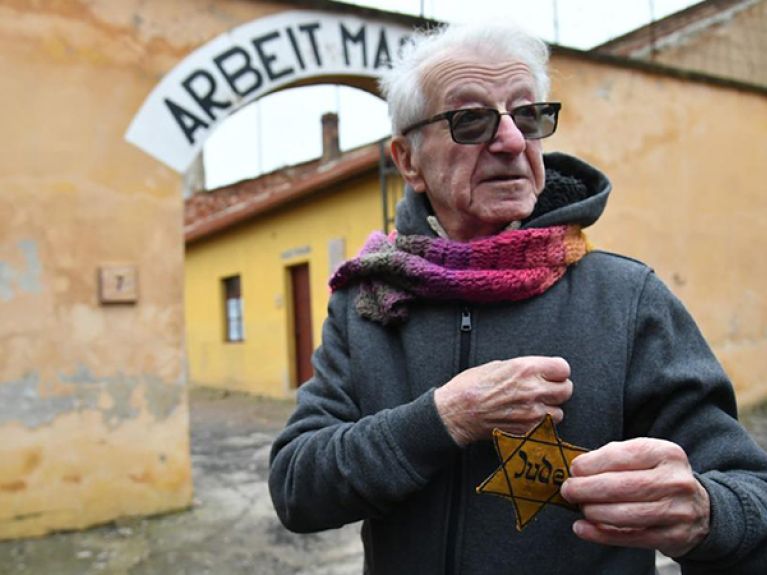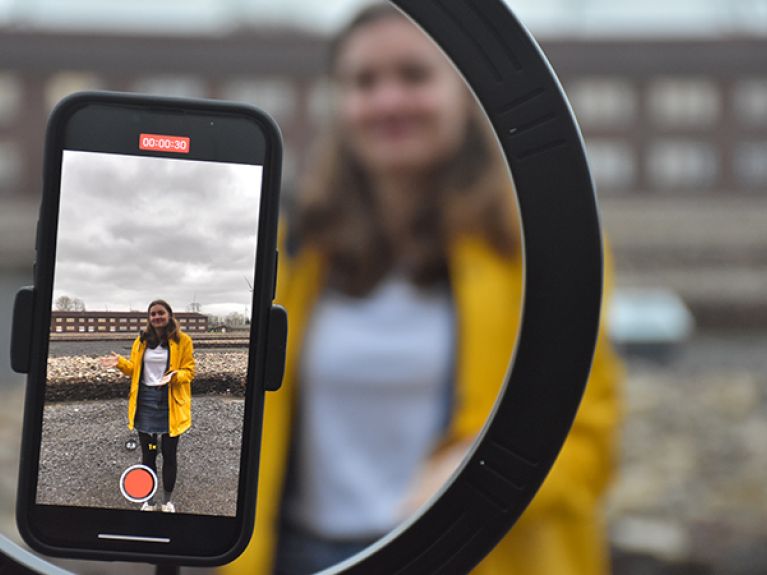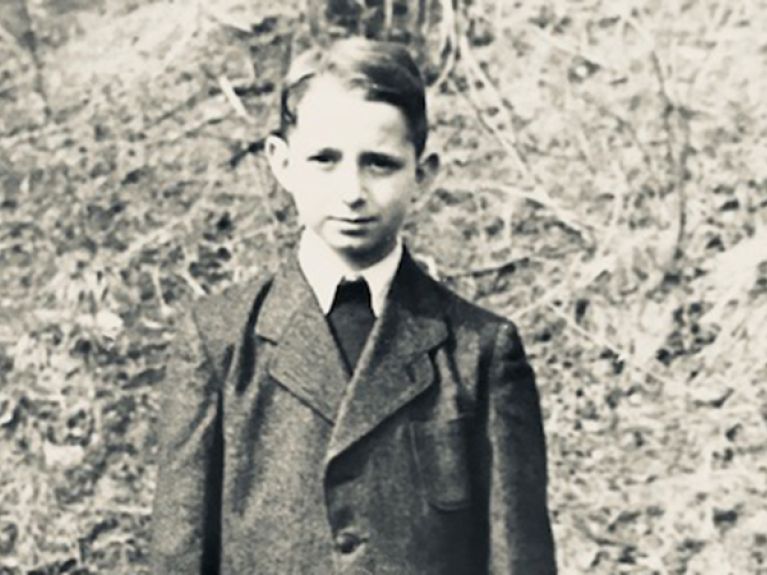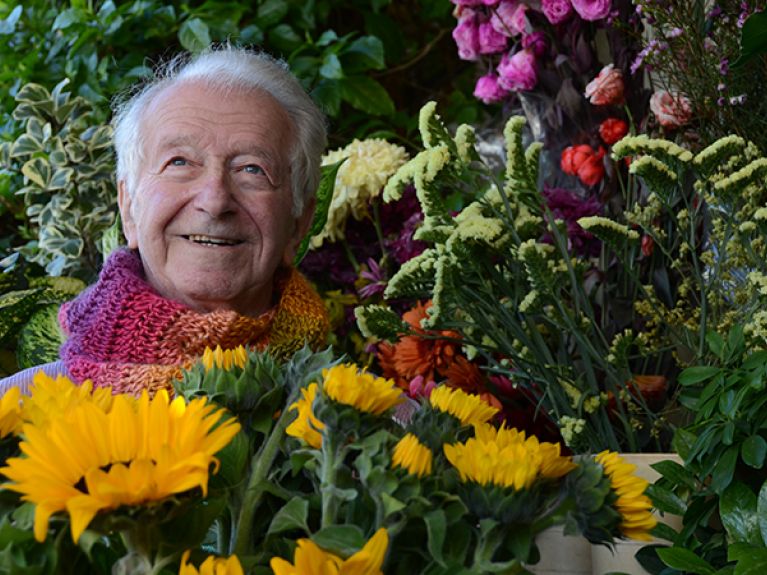Holocaust remembrance on social media
Many young people get information via TikTok – including about the Holocaust. This presents an opportunity for Holocaust survivor Gidon Lev.

Gidon Lev’s childhood ended when he was six years old. He was one of the 15,000 children at Theresienstadt concentration camp near Prague. And one of the few who survived the camp. He lost his father shortly before liberation during the prisoners’ death march to Buchenwald.
Today, 88-year-old Lev, who lives near Tel Aviv, is a TikToker with over eight million likes. Julie Gray, his biographer and life partner, set up the account with him in the summer of 2021. The two met when he was searching for someone to write his life story. Initially they wanted to use TikTok mainly to promote Lev’s book, but then they noticed that some TikTokers were comparing coronavirus vaccinations with the Holocaust. Lev responded directly – and quickly widened his reach. Nearly half a million people now follow his account @thetrueadventures Gidon&Julie, which he uses to educate them about the Holocaust.
TikToks from the everyday life of a Holocaust survivor
Besides presenting videos that explain different aspects of the Holocaust, Lev also depicts his everyday life. One TikTok from a swimming pool is captioned: “Protested at two demonstrations, told his story to sixty 8th graders and hit the pool.” Another clip shows his version of the “ancestor trend”, a staged dialogue between his own ancestors and himself. In it, Lev explains to his family from the 1940s why he uses this social media platform. He can often be seen dancing in his short videos, too – it’s his favourite hobby. “I’m grateful that I still have so much energy to put all these ideas into practice.”
Gray helps him produce the videos. “Why should we portray him as a victim? He is not defined by his trauma and his content does not have to be sad and serious. He is a man who ate spaghetti yesterday evening.” The writer also takes care of community management: “Most of the comments are positive. But the hate expressed in some posts is really awful.”
Education to combat anti-Semitism
How to deal with hatred is also an issue at Neuengamme, the first German concentration camp memorial to have its own TikTok account: @neuengamme.memorial. Those behind it quickly learned to identify right-wing strategies and key words, and explain that the opportunity presented by a video going viral can also result overnight in countless comments containing hate speech. “We have created a stop list to block certain comments from being displayed. We regard ourselves as a safe space and do not wish to expose our audience to all that,” reports press spokeswoman Iris Groschek. Gray and Lev also handle hate speech in the same way. These “filters” have to be updated regularly as right-wing language changes constantly online. Overall, Gray views this as an opportunity: “Neo-Nazis use social media in a targeted way to recruit new followers. We educate and inform young people when they simply do not know enough about certain things.”
Dialogue with Generation Z
In contrast to Lev’s approach, the work at Neuengamme follows a carefully thought-out concept. Groschek wanted to reach out to young people, “not only within the framework of a school visit but also in their everyday lives.” Clips featuring basic information are presented in the “History Toks” category, though less well-known history is also addressed – such as what happened to queer inmates. Furthermore, young people from all over the world who are doing a year of voluntary work at Neuengamme get in front of the camera to answer questions posed by the online community. The history student Marie Zachger is the current host: “I think it’s great how interactive the platform is.” Because video responses are given directly to questions, in a process known as “duets” or “stitches”, the exchange is quicker and more flexible. These social media activities are also having an impact on analogue memorial work. “The questions asked by the children are very specific because they have already seen a lot on TikTok. They then want to have things explained to them again in more detail,” says Groschek.

Lev describes first-hand experiences
Lev is involved in cooperative projects with many memorial sites, including Neuengamme, and patiently answers the questions put by the users. Outside TikTok he is mainly contacted by schools. Lev no longer has all that many memories of his early childhood, but the few he does have are very strong. In 1938, his family moved from Karlovy Vary to Prague, hoping for a life in safety. One day, however, he was no longer to use the swing he loved so much in the park there. He still remembers the sense of powerlessness he had as a child just as acutely as he recalls the icy cold on the journey to Theresienstadt and the four years of persistent fear of “being sent east”.

Though his life was saved when the camp was liberated, he was undernourished and ill in the subsequent period. Ten years old at the time, he and his mother waited in vain for their relatives. Finally, Lev arrived in Tel Aviv in 1959 and began a new life. “That’s when I understood what hope means.” His second book is about this feeling, and is also what he wants to convey via his TikTok account. “I survived the atrocity. And later I overcame two bouts of cancer,” he recounts. He is always able to look ahead to the future and inspires others with his joie de vivre. “I have six children, 15 grandchildren and two great-granddaughters. Maybe they will be able to live in a better world.”



